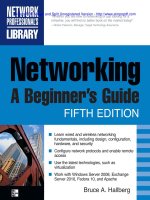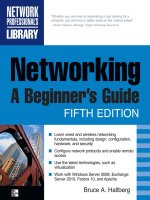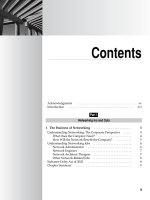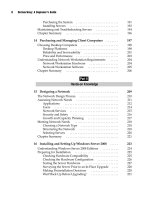Networking: A Beginner’s Guide Fifth Edition- P63 pptx
Bạn đang xem bản rút gọn của tài liệu. Xem và tải ngay bản đầy đủ của tài liệu tại đây (225.58 KB, 5 trang )
292
Networking: A Beginner’s Guide
You can use https://localhost/owa/ for testing, but Internet Explorer will likely
complain that the certificate for localhost does not match the machine name. However,
if you tell Internet Explorer to continue, it will work fine.
Figure 18-15 shows the login screen for the test user’s mailbox. Complete the login
fields as appropriate, and then click Log On to, well, log on.
You are next prompted to select your language and time zone. Choose the appropriate
selections for your location (the defaults should be correct), and then click OK to complete
the logon process.
Figure 18-13. Filling in user information for a new user with mailbox
293
Chapter 18: Introducing Exchange Server 2010
You are now in OWA, as shown in Figure 18-16. For a web-based e-mail system,
you’ll find that it’s very complete, and mimics regular Office Outlook to a large degree.
Spend some time exploring OWA. Although local users will typically use Microsoft
Office Outlook to work with the Exchange Server, you’ll find that OWA is an excellent
remote-access solution to allow users to access e-mail, calendar information, and
contacts stored on Exchange Server.
Figure 18-14. Specifying mailbox settings
294
Networking: A Beginner’s Guide
Chapter Summary
In this chapter, you installed Exchange Server 2010 onto a Windows Server 2008 server
with Active Directory. You also created a user account with an attached mailbox, and
successfully accessed it using OWA. This demonstration showed that installing and
using Exchange Server is not terribly difficult. However, if you will be working with a
Figure 18-15. Logging on to Outlook Web Access
295
Chapter 18: Introducing Exchange Server 2010
production system, you will definitely need much more information. One place to start
is Microsoft’s documentation, which you can find at />exchange/.
While there are many applications and services available for Windows Server
2008, the services described in the next chapter are mainstays that are used in virtually
every network. In Chapter 19 you learn about DHCP, DNS, remote access, Internet
Information Services, and Windows Terminal Services, all of which are a part of
Windows Server 2008.
Figure 18-16. You’re in! Outlook Web Access
This page intentionally left blank









